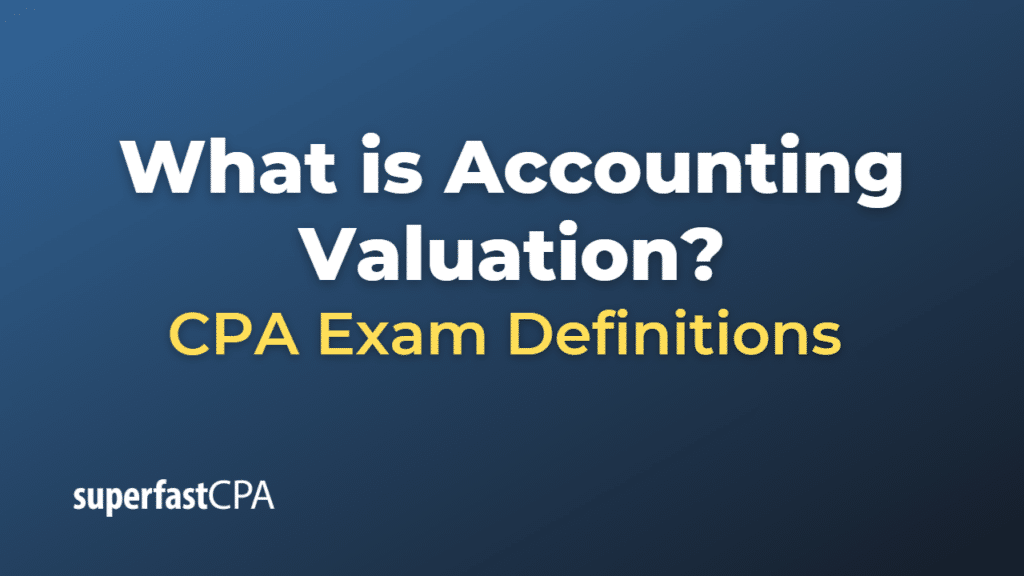Accounting Valuation
Accounting valuation refers to the process of estimating the value of an asset, liability, or equity using various methods, techniques, and assumptions based on accounting principles and standards. Valuation is an essential part of financial reporting and decision-making, as it helps determine the worth of assets and liabilities, assess the financial health of a company, and evaluate business transactions, such as mergers, acquisitions, and divestitures.
Valuation methods can be broadly categorized into three approaches:
- Cost approach: This method estimates the value of an asset based on its historical cost or the cost required to replace or reproduce the asset. It is typically used for tangible assets, such as property, plant, and equipment, and may consider factors like depreciation, impairment, and replacement costs.
- Market approach: This method estimates the value of an asset or liability based on the market prices of comparable assets or liabilities. It is commonly used for valuing financial instruments, such as stocks and bonds, as well as intangible assets, like trademarks and patents when market data is available.
- Income approach: This method estimates the value of an asset or liability based on the present value of the future cash flows it is expected to generate. The income approach is widely used for valuing investments, businesses, and intangible assets, such as goodwill and intellectual property. Discounted cash flow (DCF) and capitalized earnings methods are popular techniques within the income approach.
Accounting valuations may be subject to various assumptions and estimates, which can introduce uncertainty and subjectivity into the valuation process. Companies must follow generally accepted accounting principles (GAAP) or International Financial Reporting Standards (IFRS) when performing valuations for financial reporting purposes to ensure consistency, comparability, and transparency.
In addition to financial reporting, accounting valuations are also used for tax purposes, business planning, investment analysis, and litigation support. As a result, understanding and applying appropriate valuation methods is crucial for businesses, investors, and other stakeholders to make informed decisions and assess the financial health of an organization.
Example of Accounting Valuation
Let’s consider a fictional company, “TechWidget Inc.,” which needs to determine the value of an intangible asset – a patent for a new technology it has developed. In this example, we will use the income approach to estimate the patent’s value.
TechWidget Inc. estimates that the patented technology will generate additional revenues of $500,000 per year for the next 10 years. The company also expects related expenses (such as production, marketing, and maintenance costs) to be $300,000 per year. Thus, the net annual cash flow is $200,000 ($500,000 in revenue minus $300,000 in expenses).
To estimate the present value of these future cash flows, TechWidget Inc. needs to select an appropriate discount rate, which reflects the risk associated with the investment. In this example, the company determines a discount rate of 8%.
Using the discounted cash flow (DCF) method, TechWidget Inc. calculates the present value of the net cash flows over the 10-year period as follows:
PV = CF1 / (1+r)^1 + CF2 / (1+r)^2 + … + CF10 / (1+r)^10
Where: PV = Present value of the patent CF = Net cash flow for each year r = Discount rate
In this example, the present value of the patent can be calculated as:
PV = $200,000 / (1+0.08)^1 + $200,000 / (1+0.08)^2 + … + $200,000 / (1+0.08)^10 PV ≈ $1,240,000
Based on the income approach and the discounted cash flow method, TechWidget Inc. estimates the value of the patent to be approximately $1,240,000.
It’s important to note that the valuation is subject to various assumptions and estimates, such as the projected cash flows, the discount rate, and the patent’s useful life. Changes in these assumptions may significantly impact the valuation.
This example illustrates the process of accounting valuation for an intangible asset, which can help companies make informed decisions about investments, acquisitions, and financial reporting.













